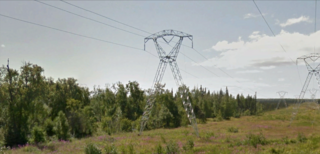 W
WThe Alaska Interconnection (ASCC) is an AC power transmission grid in North America that serves Central and Southeast Alaska. While the Alaska Interconnection is often referred to as one interconnected grid, its two parts are not connected to each other through interties, nor are the two grids connected to any other interconnection, making the grids in Alaska isolated circuits. Both grids, though, are managed by the Alaska Systems Coordinating Council as if they were one entity like the other interconnections in North America.
 W
WAn anchor portal or H-frame tower is a gantry structure supporting overhead power lines in a switchyard. Their static function is similar to a dead-end tower. Anchor portals are almost always steel-tube or steel-framework constructions.
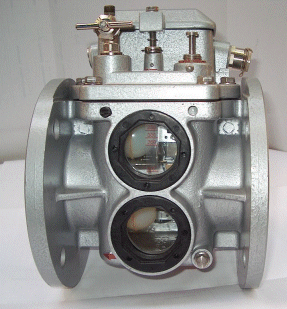 W
WIn electric power distribution and transmission, a Buchholz relay is a safety device mounted on some oil-filled power transformers and reactors, equipped with an external overhead oil reservoir called a "conservator".
 W
WThe Talcher–Kolar HVDC system, otherwise known as the East–South interconnection II is a 1450 km HVDC transmission connection between the eastern and southern regions in India connecting four states namely Odisha, Andhra Pradesh, Tamil Nadu and Karnataka. The system has a transmission voltage of ±500 kV and was originally put into service in March 2003, with a rated power of 2000 MW. In 2007 the scheme was upgraded to 2500 MW.
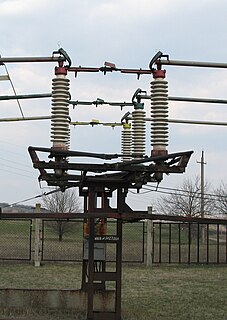 W
WIn electrical engineering, a disconnector, disconnect switch or isolator switch is used to ensure that an electrical circuit is completely de-energized for service or maintenance. They are only used for breaking the circuit and are often found in electrical distribution and industrial applications, where machinery must have its source of driving power removed for adjustment or repair. Disconnectors can be manual or motor operated and may be paired with an earthing switch to ground the portion that has been isolated from the system for ensuring the safety of equipment and the personnel working on it.
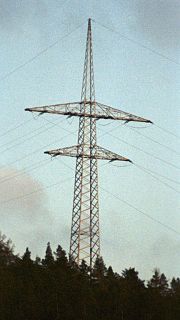 W
WThe Eyachtal Span is the crossing of the Eyach valley with a 110 kV line in Neuenbürg and Höfen an der Enz in the Black Forest in Germany. The Eyachtal Span was built in 1992. With a span of 1444 metres, it is the greatest span of a power line in Germany. The pylons on which the Eyach Span is fixed are 70 metres high and located on Heuberg and Eiberg.
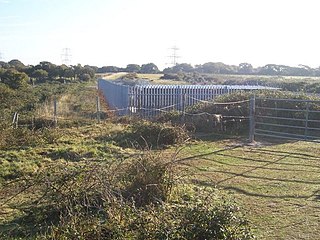 W
WFawley Tunnel is a 3-metre (9.8 ft) diameter, 2-mile (3.2 km) long tunnel under Southampton Water between Fawley Power Station and Chilling near Warsash. It was constructed between 1962 and 1965 to carry two 400 kV circuits as part of the National Grid.The tunnel was built with a 3 feet 1.125 inch gage railway to help with maintenance access. The railway was operated with a single battery powered locomotive that was scrapped in the late 70s.
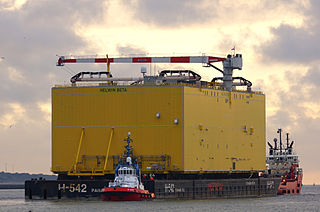 W
WHVDC HelWin2 is a high voltage direct current (HVDC) link built to transmit offshore wind power to the power grid of the German mainland. The project differs from most HVDC systems in that one of the two converter stations is built on a platform in the sea. Voltage-Sourced Converters with DC ratings of 690 MW, ±320 kV are used and the total cable length is 130 km. The project was built by the Siemens/Prysmian consortium with the offshore platform built by Heerema in Zwijndrecht, Netherlands. The topside measures 98 m x 42 m x 28 m and weighs 10200 tonnes. The project was handed over to its owner, TenneT, in June 2015, the fourth such project to be completed in 2015.
 W
WMEPSO Electricity Transmission System Operator of North Macedonia is a state-owned transmission system operator company for electricity with headquarters in Skopje, North Macedonia. It was founded in 2005 after being split from Elektrostopanstvo na Makedonija (ESM) and it is specialized in the transmission of electrical power. It is a member of the European Network of Transmission System Operators for Electricity.
 W
WThe Multihundred-Watt radioisotope thermoelectric generators is a type of US radioisotope thermoelectric generator (RTG) developed for the Voyager spacecraft, Voyager 1 and Voyager 2.
 W
WMinami-Fukumitsu Frequency Converter is the name given to an HVDC back-to-back station for the interconnection of the power grids of western and eastern Japan. This facility went in service in March 1999. It operates with a voltage of 125 kV and can transfer a power up to 300 megawatts. The station is located in Nanto, Toyama Prefecture.
 W
WMOSFET Gate Driver is a specialized circuit that is used to drive the gate of power MOSFETs effectively and efficiently in high-speed switching applications. The addition of high MOSFET Gate drivers are the last step if the turn-on is to fully enhance the conducting channel of the MOSFET technology.
 W
WIn stage lighting, a plug-in box, plug box or drop box is a device to distribute power to multiple lighting instruments, consisting of an inlet, and multiple female outlet connectors or pigtails. The electrical components are housed in or on a metal box which can be mounted to a floor, wall, or structure such as a lighting truss. Plug-in boxes often have multiple circuit breakers, and may be supplied power from a dimmer.
 W
WA rotary converter plant is a facility at which rotary converters convert one form of electricity to another form of electricity. The installed combinations of motors and generators at a plant determine the possible type(s) of conversion. Such facilities also allow the setting of voltages and frequencies, if appropriate equipment is installed. Rotary converter plants were commonplace in railway electrification before the invention of mercury arc rectifiers in the 1920s.
Sakuma was a town located in Iwata District, Shizuoka Prefecture, Japan.
 W
WShin-Shinano Frequency Converter is the designation of a back-to-back high-voltage direct current (HVDC) facility in Japan which forms one of four frequency converter stations that link Japan's western and eastern power grids. The other three stations are at Higashi-Shimizu, Minami-Fukumitsu, and Sakuma Dam.
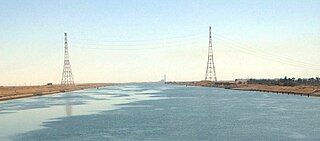 W
WThe Suez Canal overhead powerline crossing is a major electrical power line built across the Suez Canal in 1998, located near Suez, Egypt. It is designed for two 500 kV circuits.
 W
WA third-brush dynamo was a type of dynamo, an electrical generator, formerly used for battery charging on motor vehicles. It was superseded, first by a two-brush dynamo equipped with an external voltage regulator, and later by an alternator.
 W
WThe Tyson turbine is a conical water turbine with helical blades emerging partway down from the apex gradually increasing in radial dimension and decreasing in pitch as they spiral towards the base of the cone. This design doesn't need a casement, as it is inserted directly into flowing water.
 W
WThe utilization factor or use factor is the ratio of the time that a piece of equipment is in use to the total time that it could be in use. It is often averaged over time in the definition such that the ratio becomes the amount of energy used divided by the maximum possible to be used. These definitions are equivalent.
 W
W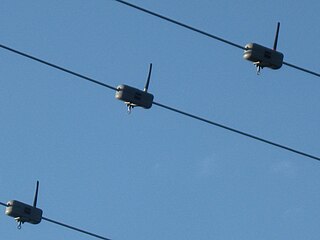 W
WA Wireless powerline sensor hangs from an overhead power line and sends measurements to a data collection system. Because the sensor does not contact anything but a single live conductor, no high-voltage isolation is needed. The sensor, installed simply by clamping it around a conductor, powers itself from energy scavenged from electrical or magnetic fields surrounding the conductor being measured. Overhead power line monitoring helps distribution system operators provide reliable service at optimized cost.